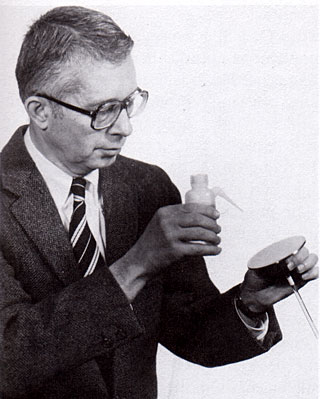
 |
Search | FAQ | US Titles | UK Titles | Memories | VaporWare | Digest | |||||||
| GuestBook | Classified | Chat | Products | Featured | Technical | Museum | ||||||||
| Downloads | Production | Fanfares | Music | Misc | Related | Contact | ||||||||
| Memories of VideoDisc - Who's Who in VideoDisc | ||||||||||||||

Richard Williams researched the capillary behavior and lubricating properties of the RCA VideoDisc. He was also a pioneer in the development of the Liquid Crystal Display (LCD), co-authoring the first paper suggesting their use in 1963, with RCA Laboratories producing the first experimental displays in 1968.
Richard Williams received the AB in Chemistry from Miami University and his PhD in Physical Chemistry from Harvard University. He joined RCA Laboratories in Princeton, New Jersey, in 1958, and is now a Fellow of the Laboratories. Dr. Williams has worked in the fields of liquid crystals, semiconductor-electrolyte interfaces, internal photoemission, properties of electrons on the surface of liquid helium, and crystallized suspensions of polystyrene microspheres. He discovered the domain structure produced in nematic liquid crystals by application of an electric field, a structure that was subsequently named "Williams Domains." He demonstrated that most compound semiconductors, in contact with an electrolyte solution, decompose on illumination and formulated the currently accepted model to explain this. In addition, this work showed that the semiconductor-electrolyte system is often a close approximation to an ideal blocking contact and can be used to establish extraordinarily high electric fields in semiconductors. Thus it became possible to make the first observation of the Franz-Keldysh electro-optic effect and to elucidate the mechanism of dielectric breakdown in CdS and ZnO.
Dr. Williams also pioneered in the use of internal photoemission as a tool for determining the properties of metal-semiconductor and metal-insulator interfaces, and demonstrated both electron and hole photoemission. This was used to establish the energy-band relations at the silicon-SiO2 interface and to determine the concentration and properties of electron traps in the oxide. Together with a colleague, he developed the corona charge method for observing effects of very high electric fields in SiO2. This was used to determine the dielectric breakdown field strength of oxide and to observe the motion of impurity ions in the oxide at room temperature. Scanning photoemission measurements were used to show that there are often lateral inhomogeneities in the distribution of impurity ions in the oxide and to relate this to device failure.
Dr. Williams has received several achievement awards at RCA Laboratories and shared in the David Sarnoff Team Award in Science in 1969. He was a visiting scientist at the RCA Zurich Laboratory in 1963, a Fulbright Lecturer in Sao Carlos, Brazil, a summer school lecturer at Instituto Politecnico Nacional in Mexico, and a visiting lecturer at Princeton University. He is a Fellow of the American Physical Society and a Corresponding Member of the Brazilian Academy of Sciences. Dr. Williams is now working on methods for energy storage and applications of solar energy.
- RCA 1982 Company Biography
Richard Williams received the AB in Chemistry from Miami University and his PhD in Physical Chemistry from Harvard University. He joined RCA Laboratories in Princeton, New Jersey, in 1958, and is now a Fellow of the Laboratories. Dr. Williams has worked in the fields of liquid crystals, semiconductor-electrolyte interfaces, internal photoemission, properties of electrons on the surface of liquid helium. More recently he has been working on the properties of phosphorus.
- RCA 1984 Company Biography
Search for patents issued to Richard Williams.
If you have some additional information to supply on Richard Williams, feel free to submit the form below, so your comments can be added to this page.
Send your comments in email via the Contact page